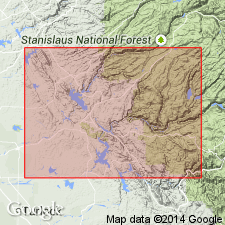
- Usage in publication:
-
- Calaveras formation
- Modifications:
-
- Named
- Biostratigraphic dating
- Dominant lithology:
-
- Quartzite
- Limestone
- Schist
- AAPG geologic province:
-
- Sierra Nevada province
Summary:
[Named for occurrence in Calaveras Co, CA]. "The term 'Calaveras formation' as used by the United States Geological Survey on the geological maps of the Gold Belt [folios 3 and 11, then in preparation] includes all the Paleozoic sedimentary rocks of the Sierra Nevada. The two belts of rock just described thus belong to the 'Calaveras formation.' " p.309. Belt of Carboniferous rocks of Bear Mountain lies just west of diabase ridge that forms high ridge of which Bear Mountain and Mount Joaquin are culminating points. Rocks of this belt are not in general greatly altered and consist of fine-grained siliceous rocks, quartzites, and limestone with much black argillaceous schist. The belt lying to east of Mother Lode is much more altered. Both belts contain some fossils which include FUSILINA CYLINDRICA and rounded crinoid stems. [Note in correspondence on p.425 "it was not intended to include in 'Calaveras formation' the Grizzly Mountain Silurian beds described by Mr. Diller, nor the upper Carboniferous strata of Genesee valley, called by Mr. Diller the Robinson beds." Thus age of Calaveras is early Carboniferous [Mississippian].
Source: GNU records (USGS DDS-6; Menlo GNULEX).

- Usage in publication:
-
- Calaveras group*
- Modifications:
-
- Revised
- Areal extent
- Biostratigraphic dating
- AAPG geologic province:
-
- Sierra Nevada province
Summary:
Calaveras formation of Becker, Lindgren, and Turner as mapped in their Placerville (folio 3) and Jackson (folio 11) sheets is raised to Calaveras group and includes Arlington formation, Shoo Fly formation, and Peale formation in the Taylorsville region. Shown on geologic map of Indian Valley area. Separated from Taylorsville formation of Devonian age by metarhyolite. Separated from Robinson formation of Carboniferous age by meta-andesites. Age is Carboniferous based on fossils identified by G.H. Girty and Charles Schuchert. List included.
Source: GNU records (USGS DDS-6; Menlo GNULEX).
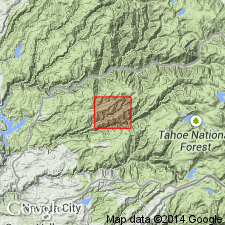
- Usage in publication:
-
- Calaveras formation*
- Modifications:
-
- Revised
- Areal extent
- AAPG geologic province:
-
- Sierra Nevada province
Summary:
Formations which lie between base and top of Calaveras formation as mapped in Colfax and Downieville folios are regarded as Carboniferous age. Map legend shows Blue Canyon formation, Tightner formation, and Kanaka formation correspond to Calaverous formation of previous reports. [Calaveras group thus is no longer used].
Source: GNU records (USGS DDS-6; Menlo GNULEX).
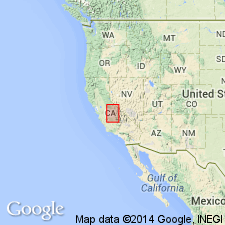
- Usage in publication:
-
- Calaveras Complex
- Modifications:
-
- Revised
- Areal extent
- Age modified
- AAPG geologic province:
-
- Sierra Nevada province
Summary:
Calaveras Complex (formerly Calaveras Formation) is defined as younger of two Paleozoic metamorphic complexes that lie east of Melones fault zone. Forms terrane between 36 deg N and 38 deg 45'N bounded on west by Melones fault zone and Kings-Kaweah suture and on east by rocks of Sierra Nevada batholith. Divided into four lithologic units: volcanic, argillite, chert, and quartzite units. Available evidence (fossils and stratigraphic) suggests Calaveras Complex formed between Carboniferous to Permian and Early Jurassic time.
Source: GNU records (USGS DDS-6; Menlo GNULEX).
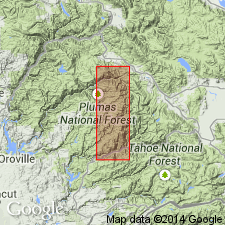
- Usage in publication:
-
- Calaveras Formation*
- Modifications:
-
- Age modified
- Biostratigraphic dating
- AAPG geologic province:
-
- Sierra Nevada province
Summary:
Calaveras Formation in area west of Melones fault is Pennsylvanian age on basis of conodonts ranging from Pennsylvanian into Permian in limestone lenses and on K-Ar ages of 271 to 248 Ma from amphibolite intruding Calaveras.
Source: GNU records (USGS DDS-6; Menlo GNULEX).
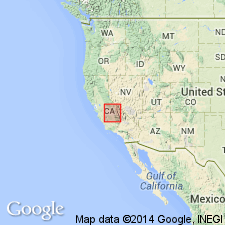
- Usage in publication:
-
- Calaveras Formation*
- Modifications:
-
- Areal extent
- AAPG geologic province:
-
- Sierra Nevada province
Summary:
Calaveras Formation considered to be part of Merced River terrane and only on east side of Melones fault. May be southward continuation of Shoo Fly Formation. Overlies ophiolite. Metasedimentary rocks of Merced River terrane are dated by sparse Carboniferous and Permian fusulinids, brachiopods, corals, and pelecypods.
Source: GNU records (USGS DDS-6; Menlo GNULEX).
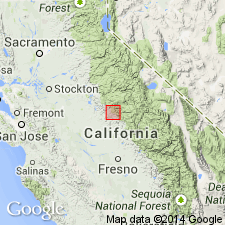
- Usage in publication:
-
- Calaveras Formation*
- Modifications:
-
- Age modified
- Biostratigraphic dating
- Areal extent
- AAPG geologic province:
-
- Sierra Nevada province
Summary:
Name "Calaveras Formation" not used east of the Melones fault zone in vicinity of and north and east of Mariposa (37 deg 30'N) because status of Calaveras Formation is uncertain and Calaveras Complex of Schweikert and others (1977) was reduced by them to only a small part of original concept. Rocks in area of report formerly considered to be Calaveras Formation are assigned informal names (east to west): quartzite of Pilot Ridge, phyllite and chert of Hite Cove, phyllite of Briceburg, and greenstone of Bullion Mountain. Phyllite and chert of Hite Cove contains Early Triassic (Griesbachian and Smithian) conodonts (in limestone beds); phyllite of Briceburg contains Early Triassic (Smithian) conodonts. Greenstone of Bullion Mountain has Early Jurassic Rb-Sr isochron age (187 +/-10 Ma) in its western part and Late Jurassic (late Oxfordian) ammonite near Melones fault zone. The fossil and isotopic data indicate apparent westward younging of all of these strata, which is reverse of eastward younging assumed in the past.
Source: GNU records (USGS DDS-6; Menlo GNULEX).
For more information, please contact Nancy Stamm, Geologic Names Committee Secretary.
Asterisk (*) indicates published by U.S. Geological Survey authors.
"No current usage" (†) implies that a name has been abandoned or has fallen into disuse. Former usage and, if known, replacement name given in parentheses ( ).
Slash (/) indicates name conflicts with nomenclatural guidelines (CSN, 1933; ACSN, 1961, 1970; NACSN, 1983, 2005, 2021). May be explained within brackets ([ ]).

